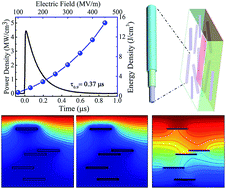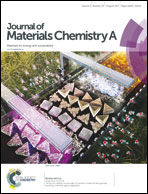Multilayer hierarchical interfaces with high energy density in polymer nanocomposites composed of BaTiO3@TiO2@Al2O3 nanofibers†
Abstract
Polymer nanocomposites with high energy density have potential applications in advanced electronics and electric power systems. The inevitable electrical mismatch between nanofillers and the polymer matrix could compromise the energy storage capability and dielectric properties of the polymer nanocomposites. Herein, novel core–double-shell structured BaTiO3@TiO2@Al2O3 nanofibers (BT@TO@AO NFs) were prepared via a one step method, and were incorporated into poly(vinylidene fluoride) (PVDF). The novel design of gradually varying the multilayer hierarchical interface was advantageous to alleviating the local electric field and electric current density intensification in the filler/polymer system. As compared with the nanocomposites loaded with BT NFs and BT@TO NFs, the nanocomposites filled with BT@TO@AO NFs exhibit much decreased dielectric loss, enhanced breakdown strength, and suppressed leakage current densities. Simulations were carried out to verify that the new core–double-shell structure significantly enhances the breakdown strength and energy density. As a result, the nanocomposite films loaded with 3.6 vol% BT@TO@AO NFs show a maximum energy storage density (Ue) of 14.84 J cm−3 at 450 MV m−1, which is about twelve times greater than that of biaxially oriented polypropylene (BOPP) (≈1.2 J cm−3 at 640 MV m−1). Moreover, the nanocomposite exhibits a superior power density of 4.7 MW cm−3 and an ultra-fast discharge speed of 0.37 μs. This research opens up a convenient and effective way for designing high-performance dielectric polymer nanocomposites.



 Please wait while we load your content...
Please wait while we load your content...